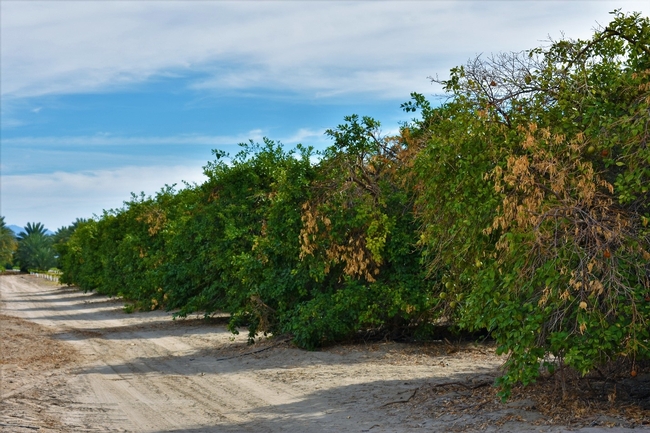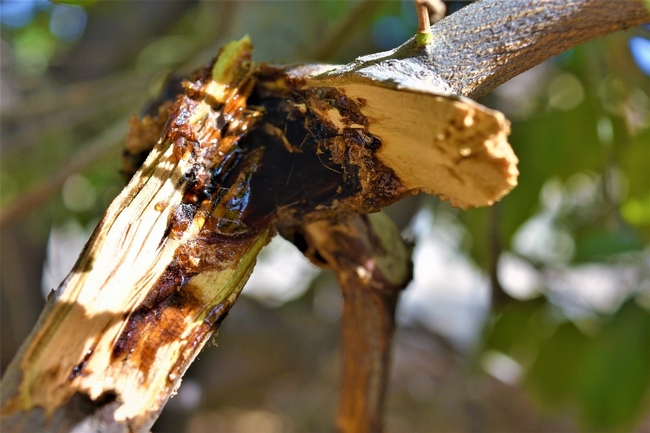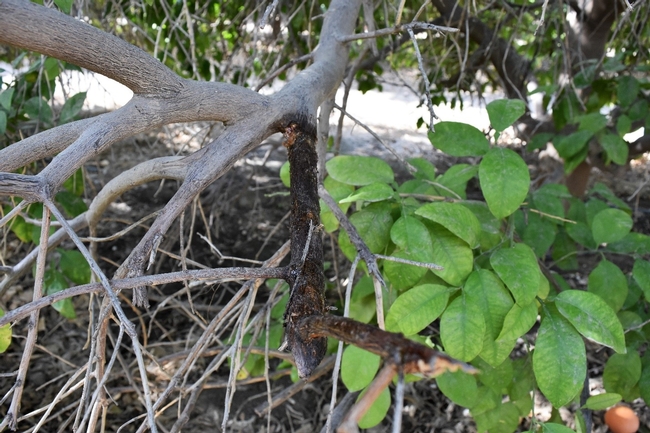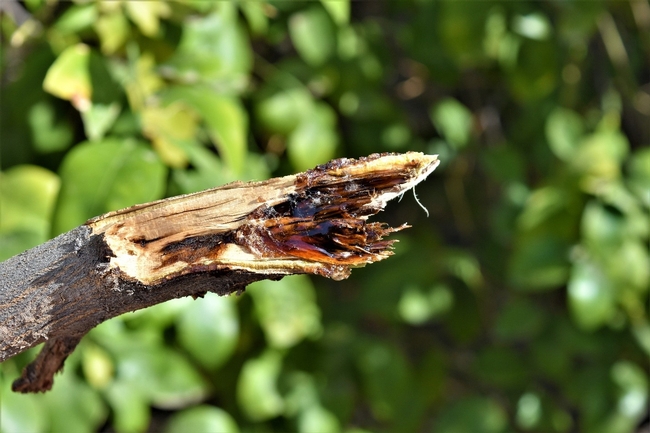
Posts Tagged: canker
What’s Up with my Avocado Tree?
So a question comes in about a problem with a backyard avocado tree. And it would seem the first question would be about the overgrowth happening at the base of the trunk. This a ‘Fuerte' avocado that is grafted on a seedling avocado rootstock. It's not unusual to see an overgrowth, but this is the most extreme example I have ever seen. So it's basically an incompatibility between the graft and the rootstock. In many cases this is no big problem and trees can live a long time, as this tree has.
But the homeowner wasn't asking about the unusual growth at the base, but the canker that had appeared in the center of the trunk near the base.
This has the classic white sugar exudate that occurs with a wound of any kind in avocado. The sugary sap that contains the unusual mannoheptulose 7-carbon sugar characteristic of the laurel family to which avocado belongs will ooze out of the wound and result in a white crust (Read more about this sugar at: https://www.sciencedirect.com/science/article/pii/S0254629911001372 ).
Anyway, so this backyard tree is in an area that is getting 10 minutes of lawn watering a day. Lawns and avocados don't get along. And avocados don't get along with short, shallow irrigation that result in salt accumulating in the root zone. Which is what has happened here. Salt stress and the result is an infection of bacterial canker (https://ucanr.edu/blogs/blogcore/postdetail.cfm?postnum=7920 ).
It's not fatal in an old tree like this, but it can predispose the tree to root rot. And that's not something that is easy to treat in backyard settings.
UC Ag Experts Talk - Avocado
UC Ag Expert talks about avocado diseases
Following the recent webinar on Citrus Thrips presented by Beth Grafton-Cardwell, a second webinar on Avocado Diseases will be offered in November. Check out the Thrips webinar and if interested enroll in the avocado one.
https://ucanr.edu/sites/ucexpertstalk/Past_Webinars/
or on YouTube
Date: November 14, 2018
Time: 3:00 PM - 4:00 PM
Contact: Petr Kosina pkosina@ucanr.edu
Sponsor: UC Ag Experts Talk
Location: Webinar
Event Details
Register in advance for this webinar:
https://ucanr.zoom.us/webinar/register/WN__Bj1TCaVSHG6RKg3-ASXuw
Ben Faber, UCCE Ventura Farm Advisor, will talk about avocado diseases. He will cover the identification and biology of root rot, crown rot, bacterial canker, leaf/stem blight, black streak and sun blotch. Then he will discuss the management management practices to prevent these diseases and the chemicals available to treat them. Resistance management tactics will be discussed.
Event Reminder
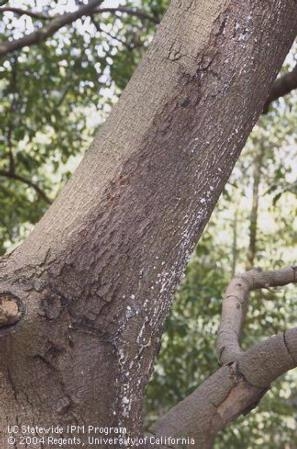
avocado black streak 1
Fungal Control of Citrus Canker Bacteria
Antarctic fungi found to be effective against citrus canker
Brazilian researchers have identified activity against Xanthomonas citri in 29 fungi isolated from samples collected in Antarctica; one of the compounds inhibited reproduction of the bacterium by up to 98 percent
A research team at the São Paulo State University's Bioscience Institute (IB-UNESP) in Rio Claro, Brazil, has identified 29 fungi with proven action against Xanthomonas citri, a bacterium responsible for citrus canker, an endemic disease in all citrus-producing countries. The origin of the fungi is surprising. They were isolated from samples of soil and marine sediment collected in Antarctica.
"These fungi live in isolated conditions and proliferate under inhospitable conditions including low temperatures and high levels of ultraviolet radiation," says Daiane Cristina Sass, a Professor at UNESP who heads a project engaged in a search for microorganisms that produce compounds with antibacterial action for use in agriculture, with support from the São Paulo Research Foundation - FAPESP.
"How have they adapted to survive in an environment so hostile to life? We wanted to see if they produced molecules with unique structures that protected them from infections and might therefore be capable of antibacterial action." Sass wrote an article published in Letters in Applied Microbiology - jointly with IB-UNESP colleagues Lara Durães Sette and Henrique Ferreira, among others - which shows some of the research's results.
More efficiency on fighting citrus canker
Although the bacterium can be combated in several ways, none is sufficient to eradicate the disease. Therefore, new chemical or biological methods of protecting citrus groves have to be pursued.
The disease is controlled directly by growers. The recommended measures include spraying trees with copper-based products and replacing infected trees with healthy new plantings derived from more resistant varieties. Control of the citrus leaf miner (Phyllocnistis citrella) is also advisable. The wounds made by larvae of this moth in feeding on the plant exacerbate citrus canker by serving as an entry point for X. citri.
"The main method for combating citrus canker consists of spraying trees with copper compounds. The downside is that when even small amounts are used for a long period, copper accumulates in the fruit, soil and water, eventually contaminating the entire environment. For this reason, we're looking for new compounds that are less aggressive to the environment and also less harmful to humans," Sass explained.
Collection and isolation of the Antarctic fungi
On the extent of the Sass-headed project and its research on biotechnology, the team came up with the idea of investigating the collection of fungi curated by Professor Sette, which resulted from Antarctic summer expeditions to the South Shetland Islands in 2013 and 2015 as part of Project Microsfera, conducted under the aegis of the Brazilian Antarctic Program (PROANTAR) and sponsored by the National Council for Scientific & Technological Development (CNPq).
Sette leads the project "Marine and Antarctic mycology: diversity and environmental application", also supported by FAPESP.
Sette isolated 33 filamentous fungi from samples collected in soil under rotten wood on Deception Island and 53 filamentous fungi from marine sediments at a depth of 20 meters in Admiralty Bay, King George Island. All fungal strains are kept at UNESP's Microbial Resource Center (CRM).
The FAPESP-funded research found that 29 of the 86 Antarctic fungi they isolated (19 of marine origin and ten terrestrial) contained compounds with proven action against X. citri.
Isolating the compounds produced by the fungi and verifying their antibacterial activity involved several stages. The process began with isolation of the fungi, which were then grown for several days in culture dishes with nutrients.
The fungi were cultured in liquid medium and shaken for 20 days at 15 °C. The solid biomass was separated from the liquid portion, and both parts were submitted to processing with solvents to obtain intracellular and extracellular extracts.
Tests
The researchers obtained 158 extracts. Each extract was diluted at several concentrations (2.10 mg/ml-0.02 mg/ml) and tested against X. citri. In the case of the soil fungi, most of the extracts with antibacterial action were intracellular in origin, while for the marine fungi, only the extracellular extracts hindered the bacterium's growth.
"We wanted to determine the lowest concentration of each extract that inhibited growth in 90% of cases," Sass said.
Some (12) of the extracts affected bacterial growth at lower concentrations than the highest tested, and ten of these inhibited growth in more than 90% of cases at concentrations of 1.5 mg/ml-1.0 mg/ml.
"At maximum concentration, one extract inhibited growth by up to 98%, and another inhibited it by about 80% at 0.52 mg/ml," Sass said. "It's important to note that we're talking about extracts [which contain varying amounts of molecules]. If an extract contains only one compound that's responsible for this bioactivity, the compound may display good antibacterial activity at much lower concentrations."
Twenty of the isolated fungi with action against X. citri belonged to the genus Pseudogymnoascus and were extracted from terrestrial and marine samples. Next came Penicillium (five), followed by Cadophora (two), Paraconiothyrium (one) and Toxicocladosporium (one), all extracted from marine sediments.
Having identified the extracts with action against X. citri, the researchers are now working to find out which chemical compounds give them this antibacterial capability.
"We expect to identify and purify some of these bioactive compounds, as well as to complete toxicology testing on them, within 18 months or less," Sass said.
The researchers plan to patent the compounds they identify. They also hope to persuade pesticide manufacturers to develop commercial products for combating citrus canker based on these compounds.
https://www.eurekalert.org/pub_releases/2018-06/fda-aff061318.php
Twenty of the isolated fungi with action against X. citri belonged to the genus Pseudogymnoascus and were extracted from terrestrial and marine samples. Next came Penicillium (five), followed by Cadophora (two), Paraconiothyrium (one) and Toxicocladosporium (one), all extracted from marine sediments.

fungal mats
Case Study: Branch Canker and Hendersonula Diseases Troubling Growers in the Desert
In the fall of 2016 growers in the Coachella desert have been experience very puzzling symptoms on their grapefruit trees. One incident, symptoms the tree had gumming oozing from the branches (Fig. 1). Usually if it were oozing from the stump it would be a root disease such as Phytophthora spp. After photos and branch samples were taken to the Plant Pathologist at University of California, Riverside, Dr. Akif Eskelan, results determined that the trees had branch canker and Hendersonula Disease.
Symptomology
Infection by Nattrassia mangiferae (Hendersonula toruloidea) causes bark cracking and peeling or dead bark that remains tightly attached to dead limbs. Black, sooty growth may develop beneath infected bark. Brownish moist areas appear on limbs during the first stages of disease, then the bark in these areas cracks or peels away revealing black masses of fungal spores (Fig 4.). In advance stages, the injured limbs may “bleed” profusely, oozing a sap like sticky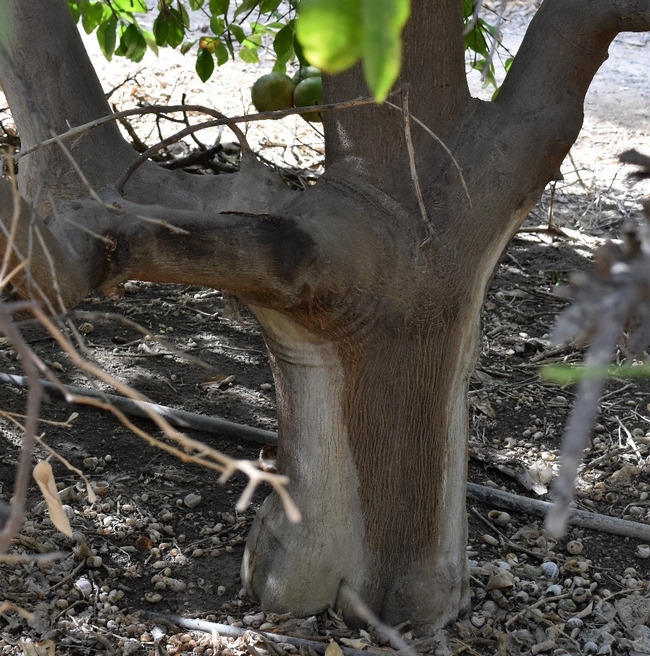
Management
Trees weakened by a disease, water stress, nutritional deficiencies, excessive pruning/mechanical damage create a are more susceptible. As many of these stressors can cause a tree to get sunburned and creates wounds that can serve as infection sites for this pathogen. Prevent sunburn by maintaining vigorous canopies through best management practices http://fruitandnuteducation.ucdavis.edu/generaltopics/ . Proper irrigation, fertilization, pruning, and pest control. Look for symptoms annually right after harvest while there are still healthy leaves on trees. Remove diseased limbs, cutting back to a lateral branch into healthy wood that shows no discoloration. Burn all infested wood, do not chip and use infected wood as mulch.
Additional Resources can be found at:
http://eskalenlab.ucr.edu/handouts/desertdieback.pdf
Water. Water. Water. And We Still Need to Learn How to Use It Right.
A recent grower survey in Santa Barbara County asked a whole bunch of questions. One of which was had they had an evaluation of irrigation distribution uniformity. This is a free service that can significantly improve on-farm water use and most importantly improve plant health. Avocados that don't get the right amount of water at the right time are extremely susceptible to root rot. Proper irrigation is the first line of defense against root rot, good farming that results in good economic returns to the grower.
So, with a free DU available to growers, how many do you think took advantage of the service? Barely 50%!!!!!!!! This just does not make sense. In a land of little water and frequent examples of what can happen with no water ………………..and high priced water, what is going on?
The local Resource Conservation District has done many system evaluations, and most results find that improvements can be made in distribution uniformity. This is true in relatively new irrigation installations. It does not take long for problems to occur in even well designed and installed systems.
During the summer of 2007, the Casitas Municipal Water District (CMWD) contracted with the Irrigation Training and Research Center (ITRC) of California Polytechnic State University, San Luis Obispo, to conduct field evaluations of drip/micro systems. A team of two students conducted 35 field evaluations.
Distribution Uniformity (DU) – DU is a measure of the uniformity of water application to trees throughout an orchard, with DU = 1.0 being perfect. The measured orchard DUs in the Santa Barbara/Ventura area had an average DU of 0.66, while the California state average for drip/micro is 0.85.
In general, there were substantial opportunities to improve the distribution uniformity (DU) of the water to trees throughout an orchard. An improved DU will minimize over-irrigation in some areas, and reduce under-irrigation in others. Key recommendations that were provided included:
Install a pressure regulator at the head of every hose
With a regular microsprinkler, doubling the pressure causes about 40 percent more water to come out of the nozzle. Pressure regulators are added to have similar pressures throughout the orchard and thus reduce the risk of over-irrigating portions of the field. On many farms, the difference between the highest pressures was double or even triple the lowest pressures (40-70% more water). By adding the correct high-quality, pre-set pressure regulators with the correct flow rate rating, the farmer can get similar pressures to every nozzle and prevent over-irrigation.
For a pressure regulator (PR) to work, more pressure must enter the PR than what the PR is rated for. For example, to use a 25 psi PR, you need at least 27 psi into the PR. All a PR does is reduce pressure; it cannot add pressure.
Another problem on hillsides is that some pipes have as much as 100 psi before the PR. A PR can effectively reduce the pressure down to 50%. What is recommended in these fields is to reduce the pressure in the pipe by adding an in-line valve halfway down the hill and throttling it down to a reasonable pressure.
Completely replace all microsprinkers with pressure compensating microsprinklers
Pressure compensating microsprinklers have an internal flexible diaphragm that reduces a pathway as the pressure increases. These allow similar amounts of water to get the trees even if the hoses do not have the same pressures. Whenever the pressure is doubled, 10 percent more water will come out of these emitters, compared to 40 percent more water with a regular microsprinkler. Having pressure compensating emitters can drastically improve the DU in virtually every avocado orchard because most irrigation systems were not properly designed for microsprinkler systems, or because the farmer has altered the original design by adding different-sized nozzles.
Reduce plugging problems
Major plugging problems are found in all orchards that did not have good filtration, even those that get district water. There were also some “within-system” causes of plugging. Almost all plugging is from simple dirt or rust, as opposed to bacteria or algae. Recommendations are as follows:
- Always have a filter at the head of the system. The required mesh size depends on the microsprinkler flow rate, but 120 mesh is a starting point.
- Remove hose screen washers that are found at the head of hoses, and replace them with regular washers (after installing a filter at the head of the system). The hose screen washers often plug up and cause the hoses to have unequal inlet pressures.
- Be sure to thoroughly flush hoses after any hose breaks.
- Double check the type of fertilizer that is being injected, especially any “organic fertilizers”. Some of these can plug emitters. In any case, inject the fertilizers upstream of the filters. If the filter plugs up, it is better to have discovered the problem early.
- Clean the filters frequently. Install pressure gauges upstream and downstream. When the pressure differential (as compared to a clean screen) increases by 3-5 psi, it's time to clean the screen.
In some orchards, there is a big plugging problem caused by insects crawling into emitters after the water is shut off. Many of the new microsprinkler designs utilize a self-closing mechanism to prevent insects from coming into the nozzle.
We have gotten a reprieve with the rains and refilled reservoirs, but it is ever more important to make sure our irrigation systems are doing what they are supposed to be doing. Call your local Resource Conservation District and get information about a system evaluation. Contact numbers can be found at: http://www.carcd.org/rcd_directory0.aspx
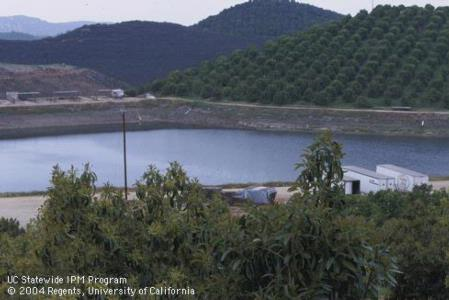
irrigation pond



